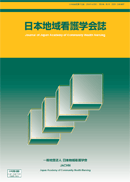Volume 10, Issue 2
Displaying 1-14 of 14 articles from this issue
- |<
- <
- 1
- >
- >|
-
Article type: Article
2008Volume 10Issue 2 Pages 7-13
Published: March 25, 2008
Released on J-STAGE: April 20, 2017
Download PDF (461K) -
Article type: Article
2008Volume 10Issue 2 Pages 14-19
Published: March 25, 2008
Released on J-STAGE: April 20, 2017
Download PDF (403K) -
Article type: Article
2008Volume 10Issue 2 Pages 20-25
Published: March 25, 2008
Released on J-STAGE: April 20, 2017
Download PDF (381K) -
Article type: Article
2008Volume 10Issue 2 Pages 26-32
Published: March 25, 2008
Released on J-STAGE: April 20, 2017
Download PDF (994K) -
Article type: Article
2008Volume 10Issue 2 Pages 33-39
Published: March 25, 2008
Released on J-STAGE: April 20, 2017
Download PDF (468K) -
Article type: Article
2008Volume 10Issue 2 Pages 40-46
Published: March 25, 2008
Released on J-STAGE: April 20, 2017
Download PDF (379K) -
Article type: Article
2008Volume 10Issue 2 Pages 47-53
Published: March 25, 2008
Released on J-STAGE: April 20, 2017
Download PDF (442K) -
Article type: Article
2008Volume 10Issue 2 Pages 54-62
Published: March 25, 2008
Released on J-STAGE: April 20, 2017
Download PDF (424K) -
Article type: Article
2008Volume 10Issue 2 Pages 63-71
Published: March 25, 2008
Released on J-STAGE: April 20, 2017
Download PDF (423K) -
Article type: Article
2008Volume 10Issue 2 Pages 72-78
Published: March 25, 2008
Released on J-STAGE: April 20, 2017
Download PDF (408K) -
Article type: Article
2008Volume 10Issue 2 Pages 79-84
Published: March 25, 2008
Released on J-STAGE: April 20, 2017
Download PDF (395K) -
Article type: Article
2008Volume 10Issue 2 Pages 85-93
Published: March 25, 2008
Released on J-STAGE: April 20, 2017
Download PDF (489K) -
Article type: Article
2008Volume 10Issue 2 Pages 94-100
Published: March 25, 2008
Released on J-STAGE: April 20, 2017
Download PDF (366K) -
Article type: Article
2008Volume 10Issue 2 Pages 101-107
Published: March 25, 2008
Released on J-STAGE: April 20, 2017
Download PDF (405K)
- |<
- <
- 1
- >
- >|
